For shade-loving privacy screens that deer won’t touch, choose Mountain Laurel and Inkberry holly as your foundation. Add Japanese Pieris for fragrant flowers and evergreen structure. Boxwood, Japanese Plum Yew, and Leatherleaf Viburnum also thrive in low light while deterring deer. Create depth by layering taller plants behind shorter ones, and incorporate aromatic herbs to further confuse hungry visitors. These strategic combinations will transform your boundary into an impenetrable yet beautiful barrier.
Understanding Deer Browsing Habits in Shaded Landscapes
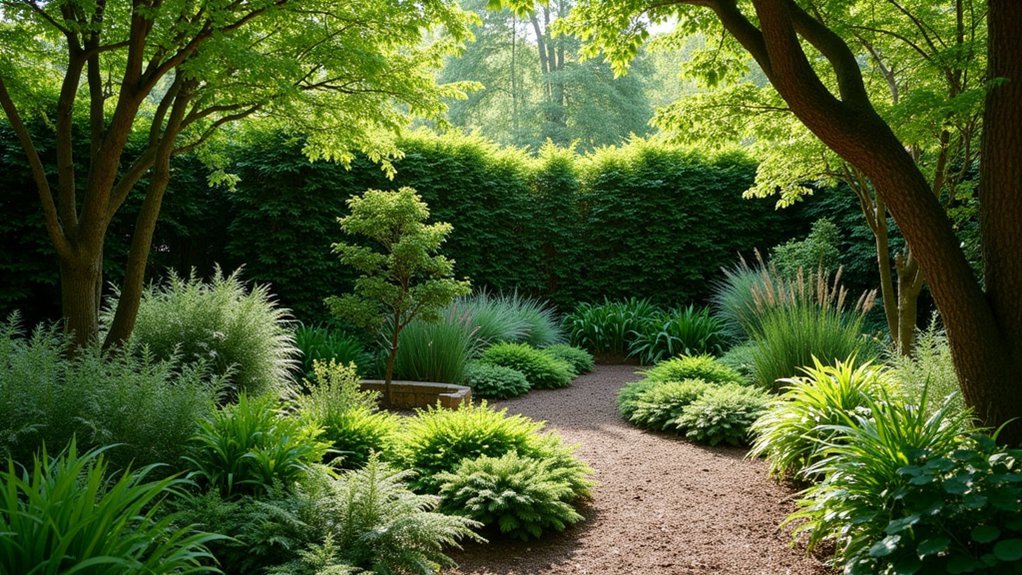
While many gardeners struggle with deer damage throughout their landscapes, shaded areas often experience less browsing pressure than sunny spots. This is because deer typically prefer feeding on plants that flourish in sunlight, where their favorite food sources tend to grow.
In shaded landscapes, you’ll notice deer are particularly avoidant of plants with strong aromas or rough textures. These natural deterrents make certain fragrant varieties excellent choices for privacy screens in shadier portions of your yard.
Most deer-resistant plants suitable for shade feature thick or tough foliage that deer find unappetizing. Though local deer populations may vary in their eating habits, shaded areas with limited food options generally see fewer deer visits, making them strategic locations for establishing effective privacy screens using plants like Mountain Laurel and Inkberry.
Top Evergreen Shrubs for Shade Boundaries That Deer Avoid
Creating effective shade boundaries requires evergreen shrubs that resist deer browsing while thriving in low light.
You’ll find boxwood hedges, Japanese plum yew, and mountain laurels particularly valuable for their year-round foliage and deer resistance.
These tough performers maintain their structure and appearance even when planted along property lines where deer pressure is high.
Boxwood Hedge Options
For gardeners battling persistent deer problems in shaded areas, boxwood (Buxus sempervirens) stands as a reliable foundation for creating boundaries deer simply won’t touch.
These versatile evergreen shrubs offer the perfect solution when you need a privacy screen that thrives in both sun and shade conditions.
You’ll appreciate their manageable growth habit, typically reaching 2-4 feet in height and width, making them ideal for pathway edges or formal hedges.
Their dense foliage creates an effective deer-resistant barrier while enhancing your garden’s visual appeal.
Boxwoods respond exceptionally well to pruning, allowing you to shape them to fit your specific design vision.
Hardy in zones 5-8, they’re adaptable to various garden styles and space limitations, though they may need protection during harsh winters or in extreme sun exposure.
Japanese Plum Yew
Japanese Plum Yew stands as another exceptional option beyond boxwood for shade-loving, deer-resistant boundaries. This evergreen shrub grows 6-8 feet tall and 6-10 feet wide, creating an ideal privacy screen without dominating your landscape.
You’ll appreciate its versatility in challenging conditions, including its remarkable tolerance for both full and partial shade environments.
| Feature | Benefit | Performance |
|---|---|---|
| Deer-resistant | Saves replanting costs | Highly effective |
| Shade tolerance | Works where others fail | Excellent |
| Low maintenance | Saves time and effort | Minimal pruning needed |
| Year-round foliage | Continuous privacy | Dense, dark green |
This adaptable plant thrives in various soil types, preferring well-drained conditions. Its drought and heat tolerance make it a worry-free addition to your landscape, offering beautiful privacy screening with minimal upkeep.
Tough Mountain Laurels
Mountain laurel (Kalmia latifolia) stands among the most resilient choices when you’re seeking a deer-resistant evergreen for shaded boundaries. This remarkable native shrub grows 5-15 feet tall, creating effective privacy screens without succumbing to deer damage. The bitter taste and leathery texture of its leaves naturally repel browsing deer, saving you the frustration of damaged plantings.
You’ll appreciate mountain laurel’s year-round appeal, with its glossy foliage maintaining visual interest even through winter months. In late spring, clusters of white or pink flowers transform these sturdy shrubs into showstoppers.
Plant them in moist, well-drained acidic soil for best results. These low-maintenance evergreens thrive in partial shade, making them perfect for establishing dense, attractive boundaries that deer simply won’t touch.
Deciduous Privacy Options for Low-Light Deer-Prone Areas
When you’re struggling with persistent deer visitors while trying to create privacy in shaded areas, choosing the right deciduous plants becomes essential.
Viburnum varieties, particularly leatherleaf viburnum, offer excellent privacy screens with the added benefit of deer resistance. Their scent and taste naturally deter browsing, while providing beautiful creamy white flowers and metallic blue-black berries.
For year-round interest, incorporate Japanese Pieris with its glossy foliage and drooping white spring flowers. This deer-resistant shrub thrives in shade and attracts beneficial pollinators.
Forsythia brings early spring color with bright yellow blooms while creating an effective boundary.
Consider mountain laurel for partially shaded spots with moist, acidic soil—its abundant late spring flowers and evergreen foliage make it a perfect privacy solution in deer-prone environments.
Native Shade Plants That Naturally Repel Deer
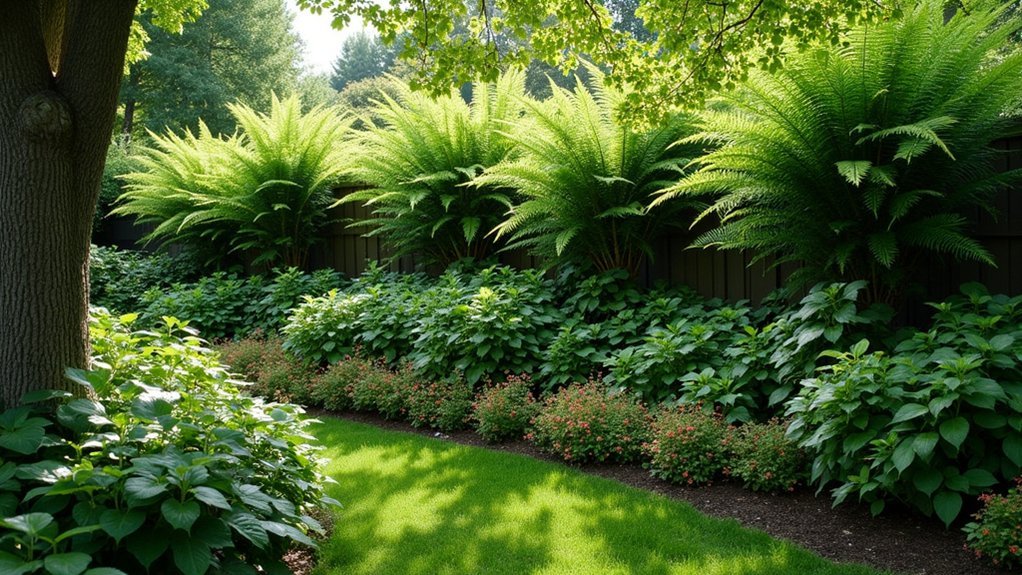
Although deer can devastate garden landscapes, our native flora offers beautiful solutions that naturally deter these persistent browsers. Mountain Laurel thrives in shade with leathery leaves and prolific blooms that local deer populations typically avoid, making it an exceptional privacy screen option.
Eastern Red Cedar, a resilient native evergreen, creates effective barriers when grouped together while rarely suffering significant deer damage.
Consider Inkberry holly for versatility across soil types and conditions. Its small black fruits add visual interest while deterring deer browsing.
Plants with fragrant foliage like Japanese Pieris naturally repel deer while attracting beneficial pollinators.
For maximum effectiveness, combine multiple deer-resistant varieties such as False Cypress and junipers. This strategy not only protects your boundaries but also enhances garden biodiversity in shaded environments.
Multi-Season Interest Plants for Year-Round Privacy Screening
Creating a year-round privacy screen requires plants that offer visual interest across all seasons while standing up to deer pressure.
Mountain Laurel and Japanese Pieris excel in part shade conditions, producing beautiful blooms while maintaining their privacy-screening capabilities throughout the year.
Shade-tolerant Mountain Laurel and Japanese Pieris offer year-round privacy with stunning seasonal blooms for added visual interest.
Inkberry holly serves as an exceptional native evergreen shrub that deer typically avoid, featuring dense foliage and attractive black berries that persist through winter.
For a dynamic boundary, combine Leatherleaf Viburnum and Little Gem Magnolia, which provide spring flowers, fall berries, and winter visual appeal.
The secret to successful deer-resistant privacy screens lies in strategic plant combinations.
Select evergreen shrubs with varied blooming periods and foliage colors to guarantee your boundary remains both functional and visually engaging year-round, regardless of season or deer activity.
Creating Layered Shade Barriers With Deer-Resistant Species
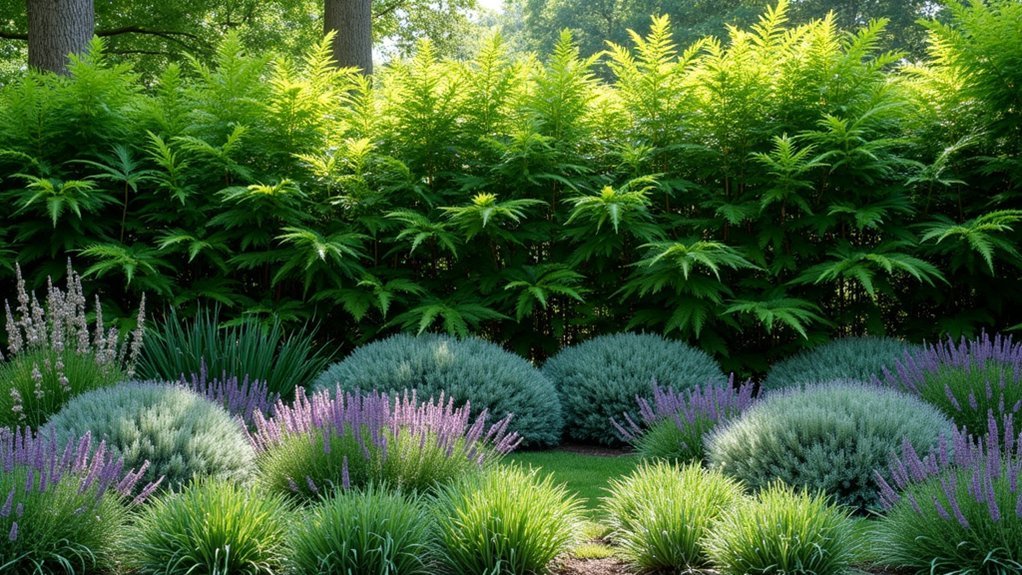
Layering your deer-resistant shade plants creates an impenetrable yet attractive barrier that deer won’t breach.
You’ll want to combine taller species like Eastern Red Cedar or Leatherleaf Viburnum with mid-height options such as Japanese Pieris and ground-level plants like Boxwood for maximum effectiveness.
This strategic pattern not only enhances visual depth but also confuses deer with varying textures and scents, making your shade garden both beautiful and functional.
Deer-Resistant Shade Combinations
When you’re struggling with both deer pressure and shady conditions, layered plantings offer a strategic solution. Combining deer-resistant plants with varying heights and textures creates effective shade barriers while maintaining visual interest year-round.
- Pair Mountain Laurel with Inkberry holly for a reliable foundation—both thrive in partial shade and rarely attract deer attention.
- Add structural elements with Japanese Pieris, whose evergreen foliage and fragrant flowers deter browsing while attracting beneficial pollinators.
- Incorporate Deutzia and Viburnum for seasonal interest—their flowers and berries enhance your screen’s appeal without tempting deer.
- Create depth by combining low-growing False Cypress with taller Leatherleaf Viburnum for multi-dimensional screening.
- Mix various textures and growth habits to establish biodiversity while maintaining an effective deer-resistant boundary in shaded areas.
Strategic Planting Patterns
To establish effective deer-resistant shade barriers, the strategic arrangement of plants matters as much as your species selection.
Design in layers, placing tall Japanese Cedar Yoshino at the back, mid-height Leatherleaf Viburnum in the middle, and compact Boxwood or Inkberry in front. This creates depth while maintaining deer resistance.
Plant in staggered rows rather than straight lines to maximize density and coverage. This mixed border approach confuses deer with varying scents and textures they find unappealing.
Combine deciduous and evergreen species for year-round coverage—evergreens provide constant structure while deciduous plants add seasonal interest.
Vary heights and textures throughout your shade boundary to enhance visual appeal while creating an effective barrier.
This strategic planting pattern guarantees privacy and protection without sacrificing aesthetic value.
Best Planting Practices for Establishing Shade Boundary Plants
Establishing a successful deer-proof boundary requires specific planting techniques that maximize plant health while minimizing deer damage. When installing plants like Mountain Laurel and Japanese Pieris, consider soil type and preparation to guarantee thriving growth in shaded areas.
- Mix organic matter into your existing soil to improve drainage and provide essential nutrients.
- Space plants according to their mature size to prevent future overcrowding.
- Water newly planted boundaries thoroughly and consistently throughout their first growing season.
- Apply a 2-3 inch layer of mulch to retain moisture and regulate soil temperature.
- Monitor plant development during establishment, adjusting care as needed.
Proper planting techniques lay the foundation for a robust deer-resistant boundary that will provide privacy and beauty for years to come.
Combining Textures and Heights for Effective Deer-Proof Screens
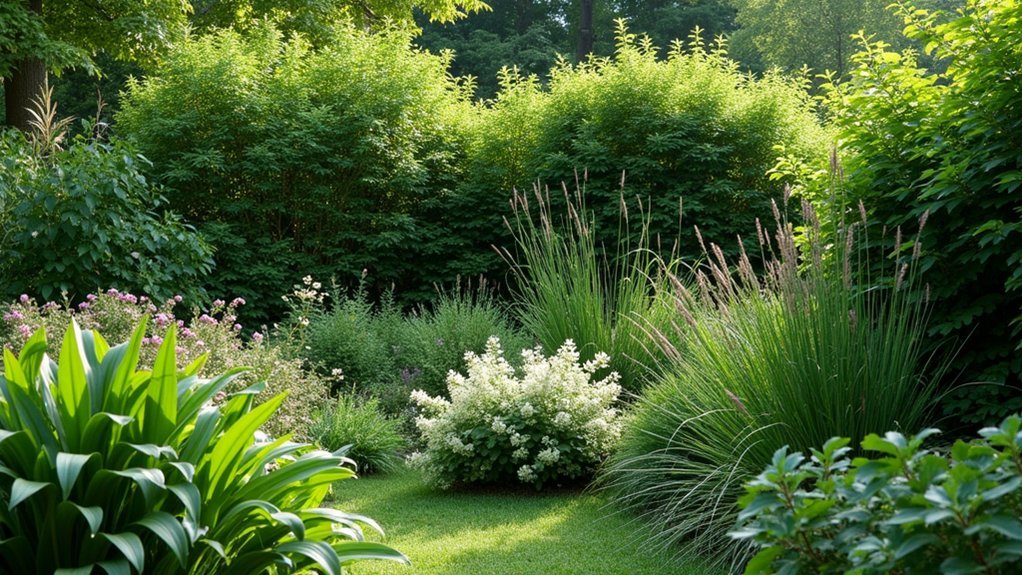
Creating a multi-dimensional deer-proof screen starts with thoughtful layering of shade-tolerant plants at varying heights.
You’ll want to position taller varieties like Cryptomeria Radicans toward the back, then gradually work forward with mid-height shrubs such as Leatherleaf Viburnum and lower-growing ferns.
The deliberate contrast between broader leaves of Mountain Laurel against the finer textures of Japanese Pieris not only deters deer but also delivers a visually striking boundary that remains interesting throughout all seasons.
Layering Shade-Tolerant Varieties
When you’re facing both deer pressure and shady conditions, strategic layering becomes your most powerful landscaping tool.
By combining shade-tolerant varieties in thoughtful arrangements, you’ll create a deer-resistant privacy screen that’s both functional and visually appealing.
- Pair Mountain Laurel with Japanese Pieris to establish a multi-textured foundation that naturally deters browsing deer.
- Stagger taller Cryptomeria Radicans behind shorter Inkberry to create depth while maintaining a dense barrier.
- Combine Eastern Red Cedar with flowering Deutzia for year-round protection with seasonal interest.
- Mix dark green Mountain Laurel foliage with glossy Skip Laurel to add visual complexity that discourages deer.
- Arrange Viburnum and False Cypress in offset layers for a robust screen that thrives in full to part shade conditions.
Contrast Creates Visual Interest
Three essential contrasts elevate a deer-proof shade garden beyond mere functionality.
Height variation creates the first dramatic effect—pair 30-40 foot Cryptomeria Radicans with 3-4 foot Coralberry to establish striking vertical diversity while maintaining deer resistance.
Texture differences form the second layer of visual interest.
Combine the glossy leaves of 15-20 foot Wax Myrtle with the delicate foliage of 6-8 foot Japanese Plum Yew to add depth and complexity to your privacy screen.
Finally, incorporate seasonal interest through thoughtful plant selection.
The vibrant blooms of 6-8 foot Heavenly Bamboo Nandina alongside the rich autumn colors of 10-15 foot Blue Point Juniper guarantee year-round appeal.
This tapestry of contrasting textures becomes especially important in shade gardens, where flower color might be limited.
Low-Maintenance Deer-Resistant Plants for Woodland Edges
The shift between garden and forest offers a perfect opportunity to establish deer-resistant plants that thrive in dappled light conditions.
You’ll find these woodland edge species provide privacy while requiring minimal care.
- Mountain Laurel creates elegant flowering screens while deterring deer with its unpalatable foliage.
- Japanese Pieris offers year-round structure with early spring blooms that deer typically avoid.
- Eastern Red Cedar provides drought-tolerant evergreen screening that deer rarely browse.
- Leatherleaf Viburnum attracts pollinators while its textured leaves remain untouched by deer.
- Inkberry adapts to various soil conditions while maintaining dense privacy barriers throughout seasons.
Strategic Placement of Aromatic Plants to Deter Deer Traffic
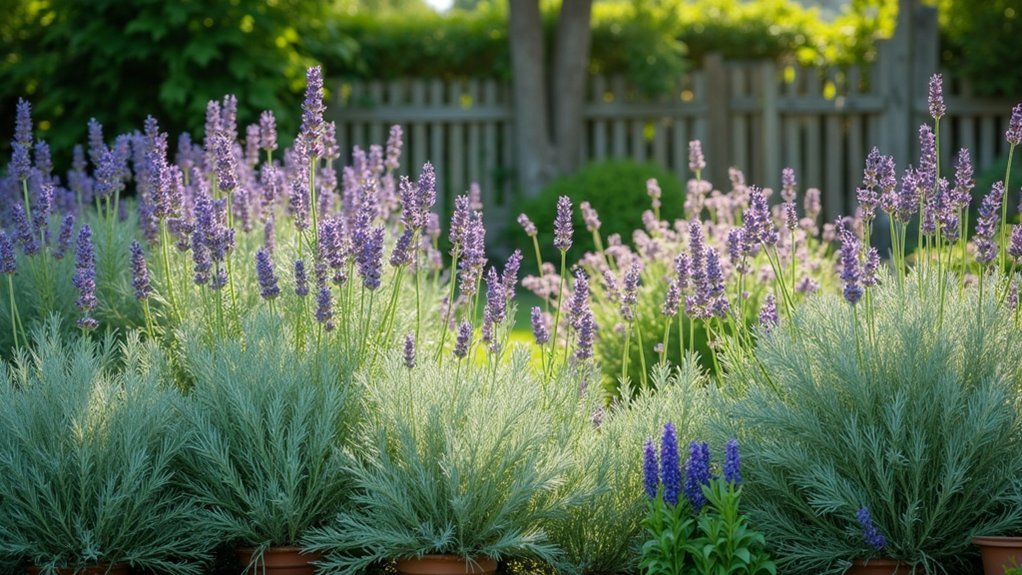
Creating a fragrant fortress around your property provides both beautiful privacy and effective deer deterrence. Position aromatic plants strategically in your privacy screens to maximize their deer-repelling potential while enhancing your garden’s sensory appeal.
| Aromatic Plant | Strategic Placement |
|---|---|
| Juniper | Property boundaries |
| Lavender | Pathway entrances |
| Rosemary | Garden perimeters |
| Sage | Near vulnerable plants |
| Thyme | Ground cover between shrubs |
Cluster these fragrant varieties around the edges of your garden to amplify their scent profile. You’ll notice considerably reduced deer traffic as these animals instinctively avoid strong-smelling foliage. By incorporating these aromatic defenders throughout your privacy screens, you’re creating multiple sensory barriers that deer prefer to avoid, effectively protecting your shade-loving plants while maintaining your desired seclusion.
Companion Planting Strategies for Enhanced Deer Resistance
Successful deer resistance relies on strategic companion planting that creates natural barriers and confusion for foraging deer.
You’ll maximize protection for your shade boundary by pairing deer-resistant native shrubs with plants that naturally repel these persistent browsers.
- Incorporate fragrant herbs like lavender and rosemary among your shade plants—their strong scents mask the appealing aromas of neighboring plants.
- Mix thorny barberries or holly with softer foliage to create physical barriers deer won’t push through.
- Plant mountain laurel and viburnum as anchor native shrubs that deer typically avoid.
- Create diversity in your plantings to confuse deer and prevent them from targeting specific favorites.
- Rotate your companion planting selections seasonally to prevent deer from adapting to your garden’s taste profile.
Maintaining Dense Growth Patterns in Shade-Tolerant Boundaries
While companion planting creates defense networks against deer, maintaining robust boundaries requires specific growth management strategies. Your shade-tolerant privacy screen needs regular pruning to encourage bushier growth and maintain ideal dimensions. This practice is especially important for plants like Boxwood and Mountain Laurel, which naturally develop dense growth patterns when properly maintained.
Incorporate both evergreen and deciduous varieties to guarantee year-round coverage and visual interest. Before planting, enrich your soil with organic material to improve drainage and nutrient availability—critical factors for healthy growth in low-light conditions.
Don’t overlook pest and disease management; healthy plants maintain denser foliage and naturally resist deer browsing. When your shade-tolerant boundaries thrive, they create an effective living barrier that deer are less likely to penetrate.
Frequently Asked Questions
What Plants Grow in Shade That Deer Don’t Eat?
For shade plants deer won’t eat, you’ll find Mountain Laurel, Japanese Pieris, Inkberry, Cryptomeria Radicans, Leatherleaf Viburnum, and Blue Point Juniper effective. They all thrive in low light while deterring hungry deer.
What Are the Best Deer Resistant Shrubs for Privacy?
For deer-resistant privacy shrubs, you’ll find Mountain Laurel, Japanese Pieris, Inkberry, Leatherleaf Viburnum, and Skip Laurel excellent choices. They grow tall enough to create effective screening while deterring deer with their unpalatable foliage.
What Annual Flowers Are Deer Resistant to Shade?
For deer-resistant annual flowers that thrive in shade, you’ll succeed with impatiens, coleus, begonias, fuchsias, and caladiums. They’re avoided by deer due to their scents, textures, or tastes while performing beautifully in low-light conditions.
What Is the Most Deer-Resistant Plant?
No plant is 100% deer-proof, but boxwood and Eastern Red Cedar offer excellent resistance. You’ll find Mountain Laurel and Japanese Pieris are also highly resistant due to their scent, texture, and chemical composition.
In Summary
Creating a deer-proof shade boundary doesn’t require sacrificing privacy or beauty. By combining aromatic deterrents with naturally resistant plants, you’ll establish a resilient screen that thrives in low light. Remember to maintain proper spacing and regular pruning for dense growth. You’ve now got the knowledge to select plants that will provide year-round privacy while keeping deer at bay—even in the challenging combination of shade and deer pressure.

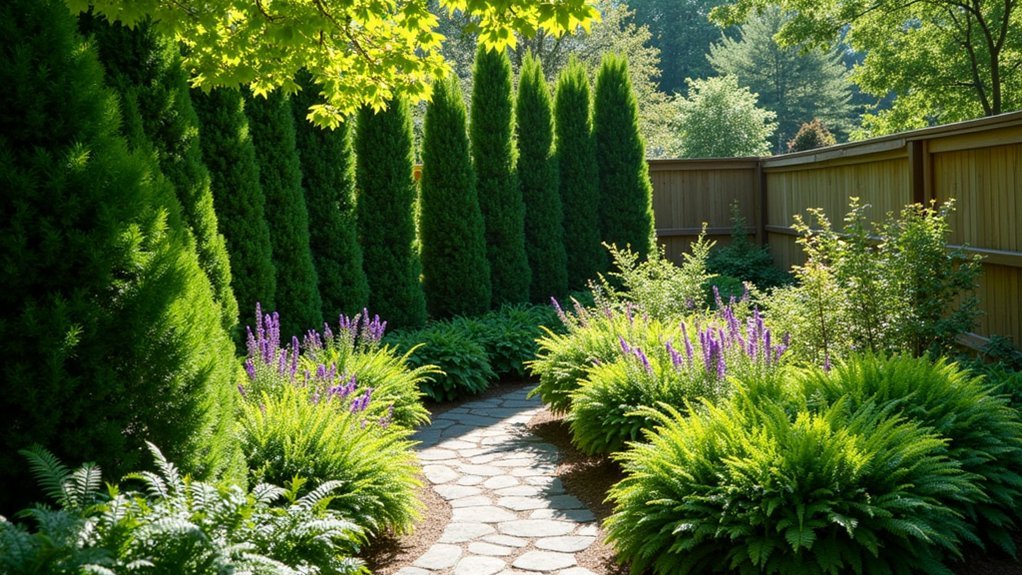



Leave a Reply